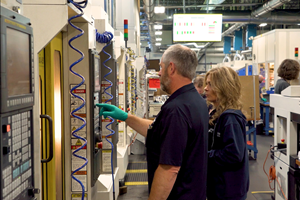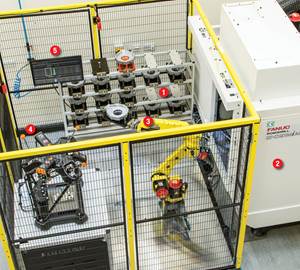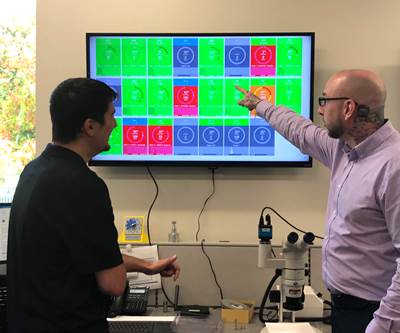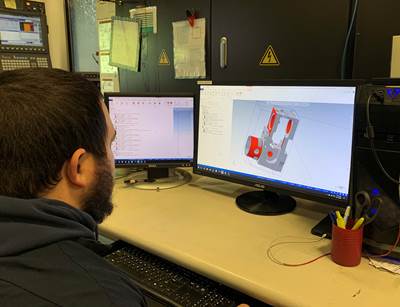The machine tools are the visible parts of a shop’s capacity, but it is hard to overstate the value and power of software tools for using that capacity effectively. Indeed, software reaches every corner of a manufacturing facility. From the ERP software in the front office, to the CAD/CAM systems that program parts and the machine monitoring programs on the shop floor, nearly every employee in a machine shop is likely to interact with some type of software program. And even those who don’t work directly with software are indirectly impacted by it.
“...nearly every employee in a machine shop is likely to interact with some type of software program. And even those who don’t work directly with software are indirectly impacted by it.”
IMTS spark showcases various manufacturing software providers and a range of new software innovations. Here are examples — software tools helping machining facilities improve efficiency. Follow links below to the IMTS spark platform for more information about any of the products mentioned here.
Shop Management Software
ERP serves as the backbone of a shop, organizing various day-to-day functions including quoting, purchase orders, project management, engineering, accounting and scheduling. Recent anecdotal evidence shows that shops have recently been giving more attention to ERP systems — they’re putting more emphasis on choosing the right solution, implementing it and making use of all the features. Whether this is due to acquisition activity that’s challenging old systems of tribal knowledge and leading new owners to implement more transparent processes, the COVID-19 pandemic bringing on a need for more and better digital communication, the shortage of skilled manufacturing workers, or other factors entirely, shops want to make full use of these systems to help their companies run more efficiently, especially in the face of the challenges of the past year.

Visual Knowledge Share (VKS) offers work instruction software that converts standard operating procedures into a paperless step-by-step format with images, videos and annotations.
Visual Knowledge Share (VKS) offers work instruction software designed to enable shops to become more lean and ready for Industry 4.0. The VKS system converts standard operating procedures into a paperless step-by-step format with images, videos and annotations. Each of the company’s VKS software packages adds capabilities to those core functionalities. VKS Lite enables users to create and share visual work instructions with the entire shop floor in minutes, the company says. VKS Pro uses Smart Forms to create quality checklists, generate reports and view live KPIs. VKS Enterprise provides integration of the system into a shop’s enterprise resource planning (ERP) or manufacturing execution system (MES). VKS Connect provides Smart Tool add-ons enabling, for example, capturing torque value and collecting data from test benches.
The 10.2.600 release of Epicor’s enterprise resource planning (ERP) software is designed to simplify work for greater productivity, provide greater access to data and automate critical business processes. The new release includes upgraded tools that allow for easier collaboration and an updated user interface. The Kinetic Application Studio for improved customization and personalization enables users to build country-, industry- or customer-specific experiences, and customize reports, trackers and dashboards with little to no code. The cloud-based Quality Management System, powered by ETQ Reliance, helps customers optimize critical quality processes. Specific quality measures in nonconformance incidents, corrective action and root cause analysis as well as management of internal test plan data provide traceability and measures the costs of quality, scrap and rework. Extended Advanced Project Management addresses the challenges of contract management and multifaceted projects with an integrated solution that can manage projects, contracts, claims, subcontractors, variations and revenue recognition.
Tooling Software Technology (TST), the North American master distributor for Visi and Peps software, has developed its own tool shop tracking software for the tooling and moldmaking industries. TSTracker is an ERP software program designed to streamline shopfloor processes and enable job tracking.
Designed to eliminate the need for on-premise servers and the costly IT support they demand, Global Shop Solutions’ cloud-based ERP software can improve accessibility, speed and security. By reducing manufacturers’ need to focus on hardware, the software solution enables them to spend more time focusing on the job at hand, knowing their data is safe and secure. With Cloud ERP, users experience Global Shop Solutions ERP software in the Amazon Web Service cloud, which the company says provides an uptime of 99.95%. More than 30 applications are available, giving users the same options as on-premise deployment customers. The ERP program is also completely customizable to the needs of any manufacturing business. Global Shop Solutions handles all updates and maintenance for Cloud ERP in-house, giving customers the most up-to-date version operating at top speed. Maintenance-free software and speed combine with quick and simple automatic cloud-based data backups so files and data are never lost.
CAD/CAM Systems and Simulation Software
After an order goes through an ERP system, a programmer must use CAD/CAM software to program the part for machining. CAD/CAM systems can have a significant impact on productivity by enabling shops to get the most out of their machines. Once part programs are written, simulation software can further increase efficiency by optimizing programs and preventing costly issues like collisions.
The latest version of HyperMill from Open Mind Technologies features

The latest version of HyperMill from Open Mind Technologies includes a Virtual Machining feature with an Optimizer to improve five-axis toolpaths.
enhancements and machining strategies that can improve the accuracy and efficiency of 3D and five-axis machining. The software’s Virtual Machining feature contains an Optimizer which is designed provide to solutions beyond simulation and identifying error conditions. These capabilities improve toolpaths that are traditionally calculated in the CAM engine, and incorporate knowledge of the part model, tooling, toolpath calculation and collision check engine, and the machine tool model with its physical constraints. The Virtual Machining Optimizer can also link individual part programs with smooth and safe connections, enabling the cutter to remain close to the workpiece.
NCSIMUL 2021 from Hexagon Manufacturing Intelligence virtually builds digital twin machining environments, which can help users avoid errors, decrease set-up times and reduce cycle times. The 2021 release features a comparison mode that detects excessive material with fast, hidden simulation, and features solid comparisons between CAD/CAM models or previous cut stock and simulated models. Used to detect unwanted rest stock on a large part, this feature generates a list of excess material that can also be displayed in a 3D window that is linked to the list. Among its benefits are the abilities to find small, missing drill holes on large aerospace components and missing holes that need to be connected on mold bodies and hydraulic parts. The NCDoc add-on for NCSIMUL also has a new “dimensioning” function that creates control instructions for operators. It produces a dimension checklist with user-defined tolerances, automatically defines the minimum measurement needed for each cut, generates a comprehensive view for the programmer and operator on the 3D simulation, and works with the NCDoc documentation template. This saves time and money, particularly when using the wizard to create the correct number of measurements, even when using a probe tool on the machine. The software also includes a new set of options to quickly evaluate tools that can benefit from air-cutting optimization, with “out of material working time” data in the sequence list. This works with the NCDoc documentation template and customizes stock nearness values for each sequence. The optimization is then automatically stored for future strategies.
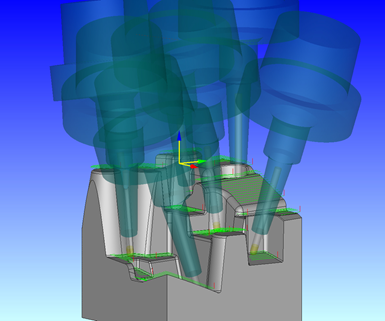
The latest version of CAM-Tool is said to short calculation times by as much as 60% compared to previous versions.
The latest version of CAM-Tool shortens calculation time by as much as 60% compared to previous versions, according to the company. The new “Only Interference” function reduces machining and calculation time by keeping as much as 3x data as possible and only applying 5x conversions when the system detects interferences. A redesigned programming interface now includes a “tree view,” which reduces the amount of mouse movement required to set up a program, and gives operators easier access to more features. The tree view also gives programmers access to any program in the process list, enabling them to reference previous programs quickly and easily. The program can also now visually display tools so programmers can determine tilt angle and cutter length. Users can right click on the tool description in the process list to view information and determine which tool to use.
Data-Driven Manufacturing and Machine Monitoring
The process of gathering data in a machine shop has become cheaper and easier in recent years. Whether directly from the machine tool, from outside software systems (such as CAM and ERP) or through sensors, machine monitoring programs collect data about machine status, temperature, spindle load, and more. Shops can then take this data and display it on dashboards, use it for benchmarking, send out real-time notifications of pending problems, and predict and prevent future issues.
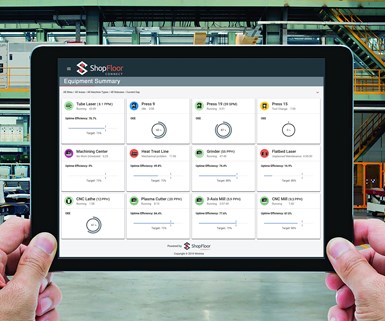
ShopFloorConnect from Wintriss Controls Group gathers machine downtime and production efficiency data, displays it in real-time and produces reports, helping shops increase capacity and profitability.
Wintriss Controls Group has released Version 6.0 of its ShopFloorConnect software program. The OEE and shopfloor data collection software can gather downtime and production efficiency data from every machine in a manufacturing operation, display it in real-time, and produce reports, including OEE reports in a variety of formats. The program is designed to increase manufacturing capacity and profitability by identifying and quantifying production losses and bottlenecks, reducing machine downtime by as much as 70%, according to the company. Version 6.0 has a new design for fast, easy access to all data. This new design includes several new features for robust, user-friendly reporting and dashboard customization; flexible scheduling capabilities; and machine interface enhancements, all of which are critical for OEE. For even better production analysis, users can now track the reasons for scrap. Version 6.0 also allows users to manually enter good and bad part count data when machines with batch processes make it impossible or impractical to automatically count the parts as they are being produced.
Related Content
Shop Quotes Smarter, Works Harder with Machine Monitoring
Temco first installed MT-LINKi to optimize quoting. Now, the software helps the shop optimize its machines — and machine purchases.
Read MoreProtecting Your Automation Investments
Shops need to look at their people, processes and technology to get the most of out their automation systems.
Read MoreSwiss-Type Control Uses CNC Data to Improve Efficiency
Advanced controls for Swiss-type CNC lathes uses machine data to prevent tool collisions, saving setup time and scrap costs.
Read More5 Stages of a Closed-Loop CNC Machining Cell
Controlling variability in a closed-loop manufacturing process requires inspection data collected before, during and immediately after machining — and a means to act on that data in real time. Here’s one system that accomplishes this.
Read MoreRead Next
Communication Clears Machine Monitoring's Morale Hurdles
When pen-and-paper methods of tracking job efficiency left AccuRounds’ engineers and managers in the dark, the shop switched to MachineMetrics. But machine monitoring brought morale challenges along with it.
Read MoreMapping the Optimal Path for Machinists
Using data from machine monitoring systems and CNC programs, OPS calculates the most efficient path for operators to take across the shop floor, improving uptime and increasing machines per operator.
Read MoreDigitalized Job Shop Scales Up
New software sparks new thinking about meeting quality certification requirements without stifling growth.
Read More



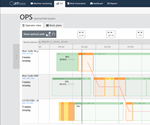
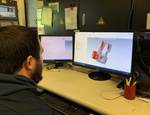




.jpg;maxWidth=300;quality=90)














